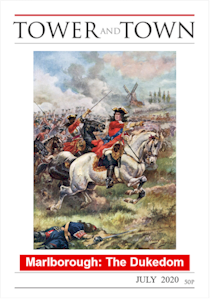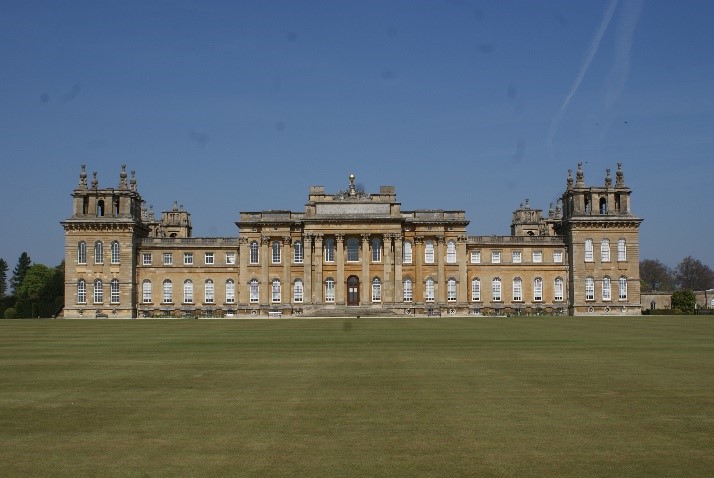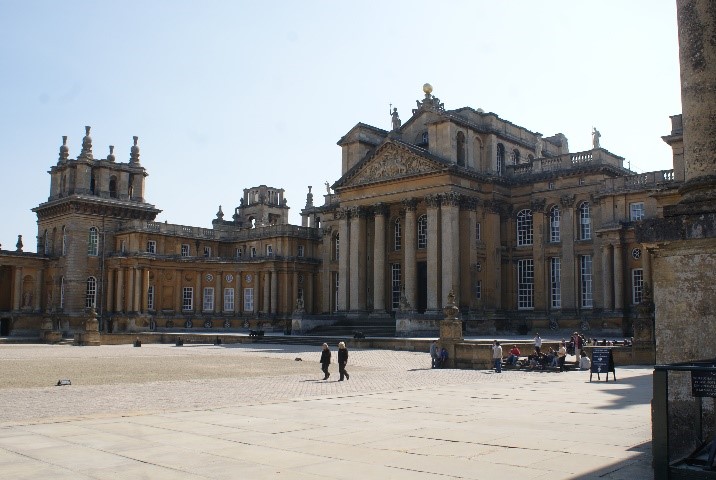

Tower and Town, July 2020 (view the full edition) (view the full edition)Blenheim PalaceThe Battle of Blenheim of 1704 has been described as one of the greatest battles in the history of warfare, which, along with the subsequent battles of Ramillies, Oudenarde and Malplaquet, put an end to Louis XIV's expansionist visions. John Churchill, 1st Duke of Marlborough, and Prince Eugen of Savoy, who together commanded the anti-French Allied forces, are rated as two of the finest soldiers in European history.  It was thought fitting therefore that a doting sovereign and a grateful nation should wish to reward the triumphant Duke with a palace worthy of a hero. The Queen therefore granted the tenancy of the royal manor of Hensington or Woodstock to Marlborough in perpetuity on the payment of a peppercorn rent of a French Royal flag each year on the anniversary of the Battle of Blenheim. (This still happens!) That is the easy bit. Gift of a grateful nation indeed, but there seemed little clarity of how much a grateful nation would contribute towards the cost, or indeed what would constitute a suitable palace. A grant of £240,000 was approved, but that was nowhere near enough, and the payment was very haphazard indeed, depending on whether Marlborough's political adversaries were in power or not. Who was to build it? That was the next problem. The architect of choice, at least the choice of the Duke's wife, the cantankerous and grasping Sarah, was Sir Christopher Wren, the revered architect of Saint Paul's Cathedral and much else beyond. He was already building Marlborough House in Saint James', London for her, but a palace in Woodstock was beyond the aged Wren. So the commission was given to John Vanbrugh, one of the most controversial and flamboyant figures of his day. As a well-connected young man, Vanbrugh had been a swashbuckling soldier who was even arrested as a spy in France, serving time in the dreaded Bastille until returning home in a 'prisoner exchange'. He then became a hugely fashionable and controversial playwright with a series of risqué plays such as the 'Provoked Wife'. Being a patentee of the Drury Lane theatre helped, of course. From playwright to architect in one easy move was helped by his association with the influential Earl of Carlisle who commissioned the inexperienced Vanbrugh to build him a new house in Yorkshire known today as Castle Howard. This house was quite unlike anything hitherto built in England, adopting a French Baroque style straight from the France of Louis XIV, which of course Vanbrugh had seen, if only from the barred windows of the Bastille. The Baroque is defined as 'whimsical, where the order and symmetry of the Renaissance architect have given way to the cult of the theatrical and imaginative. Castle Howard, with its dome, sweeping curved wings and immense south front are all of that. Not bad for a first commission. It is said that Marlborough had met Vanbrugh in the Drury Lane playhouse and, on an impulse, invited Vanbrugh to build the house for him. However, the house could never have been built without the active and constant attention of Nicholas Hawksmoor, a proper architect, trained in Wren's office and designer of many of the so-called Wren city churches. The two men had already worked at Castle Howard and were friends as well as colleagues. An experienced architect and a totally flamboyant figure, he was sympathetic to Vanbrugh's architectural imagination, but ensured that the building would actually stand up! Together Vanbrugh and Hawksmoor built the most remarkable palace with its huge courtyard on the northern side and an immense southern façade crowned with a bust of Louis XIV removed from atop of the town gates in Tournai. Blenheim is best known for its remarkable skyline with four corner towers crowned with balls (orbs) surmounted by ducal coronets. What a statement about the saviour of Europe! Some of the best craftsmen money could buy began working here, including Grinling Gibbons, better known for his spectacular limewood carvings, but here responsible for yards of mouldings and decoration. However, all was not well. Sarah Churchill and Queen Anne quarrelled irretrievably in 1710 and the Marlboroughs were in disgrace. Further money for the house (already amounting to £220,000) failed to be delivered and all building work ceased, with tradesmen and workforce owed some £45,000. In 1716, with an ageing Marlborough no longer able to oversee the completion of his house, the intractable and embittered Sarah took over in an attempt to make the house habitable. The team of first class craftsmen such as Grinling Gibbons refused to continue on the reduced wages that were being offered, while Vanbrugh was enraged by Sarah's interference and left in a rage, never to return. He wrote: 'You have an end, Madam, for I will never trouble you again unless the Duke recovers (from a stroke) so as to shelter me from such intolerable treatment'. To add insult to injury Vanbrugh, Gibbons and others failed in their case for lost income. Banned from Blenheim, Vanbrugh only ever saw something of his masterpiece in 1725 looking over the garden wall of Woodstock Rectory, while his wife was denied access to the house and gardens even as a paying tourist. Such was the eternal animosity felt by Sarah. The less choleric Hawksmoor refused to continue supervision at Blenheim although he was called back to work there in a rather fitful way, creating for example the magnificent library on the west side of the house, one of the greatest interiors of any house in Great Britain. However, even he was bypassed by Sarah for the designing of the late Duke's memorial in the chapel. This led Vanbrugh to write of his friend 'Poor Hawksmoor. What a barbarous age have his fine ingenious parts fallen into.' Sarah lived on until 1742, an astute business woman, gleefully browbeating contractors and cutting down expenses while her legendary rudeness to King and pauper alike made her a very unpopular figure. Blenheim was finished about 1735, but the meticulous accounts of the Vanbrugh era were never maintained, so neither the completion date nor the final cost can be ascertained. So Blenheim, the national tribute to this nation's greatest soldier was, in Sarah's own words, nothing but a controversial and unloved 'great heap of stones.' Go and decide for yourselves!  Alexander Kirk-Wilson |